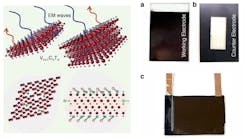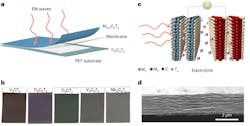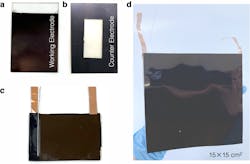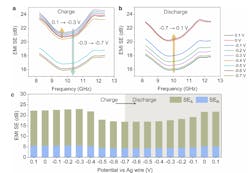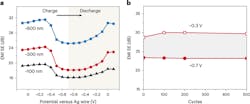This article is part of the TechXchange: Delving into EMI, EMC and Noise.
What you’ll learn:
- Why and where room-scale EMI shielding is needed.
- How MXenes can be used for electrically controllable EMI shielding.
- The performance achieved with this switchable shielding.
Many situations arise in which you need to provide RF shielding for a “public” room or large enclosed area, yet where standard anechoic-chamber EM-absorbent foam isn’t appropriate, attractive, or sufficiently rugged. Such shielding may be needed so that electromagnetic energy from within the room doesn’t leak out to avoid being intercepted or compromised. Conversely, it may be a setting where people talking on their phones would be annoying to others, such as a theater.
For example, I was in a newly renovated high-end art museum a few years back, and their “special exhibits” room was a RF dead zone. When I asked about it, they said that to maintain the user experience and quiet for these exhibits, they had buried fine-pitch wire screening in the walls to block cell signals.
Another non-foam option is metallized paint, but the paint has be properly applied, maintained, and have no gaps around doors or vents. Further, there are times when you would like to have a shielded RF enclosure that could be enabled/disabled at will, with minimal hassle.
Enter MXene
There’s a possible solution to this dilemma. MXene is a unique material in that it’s highly conductive—making it well-suited for reflecting microwave radiation and thus providing shielding. However, its internal chemical structure also can be temporarily altered to allow these electromagnetic waves to pass through.
That’s exactly what a team led by Yury Gogotsi, Distinguished University and Bach professor in Drexel’s College of Engineering, has done. They previously demonstrated that the two-dimensional, layered MXene materials, discovered just over a decade ago, can be turned into a viable “active shield” against electromagnetic waves when combined with an electrolyte solution.
What is a MXene or MXenes (pronounced “maxine” or “maxines”)? No, it’s not a clever marketing trademark or proprietary substance. Instead, it’s the formal chemical designation for a relatively new and large family of 2D transition metal carbides, carbonitrides, and nitrides (see References). Due to their interesting electromagnetic and material properties, they’re finding applications not only in shielding, but also supercapacitors, batteries, and more.
The researchers have devised a technique for modulating the reflection and absorption of incident electromagnetic waves—and thus their shielding attenuation—by using various submicrometer-thick MXene thin films. The reversible tunability of electromagnetic-interference (EMI) shielding effectiveness is implemented by electrochemically driven ion intercalation (in case you have forgotten, “intercalation” is the reversible inclusion or insertion of a molecule or ion into layered materials with layered structures) and de-intercalation.
This results in expansion and shrinkage of the MXene layer spacing and, in turn, the charge-transfer efficiency with different electrolytes (Fig. 1).
1. Electrochemically modulated EMI shielding behaviors of MXene films. (a) Schematic of the shield, which consists of MXene electrodes on a PET substrate and an electrolyte-containing polymer membrane. Mn+1CnTx: M is a transition metal (Ti, V, or Nb), C is carbon, and Tx is the surface termination. (b) Digital photos of the MXene electrodes used in this work. (c) Illustration of ion intercalation between MXene layers for tuning EMI shielding. V = applied voltage. (d) SEM image of the cross-section of a MXene film, showing the aligned layers.
Putting It to the Test
The team tested 10 different MXene-electrolyte combinations, applying each combination via a paint sprayer in a layer just a few microns thick (Fig. 2).
2. MXene-based shields: Digital images of (a) a V2CTx working electrode, (b) a Ti3C2Tx counter electrode, (c) assembled film with Ag wire as reference electrode for S-parameters measurement, and (d) a 15- × 15-cm2 shield showing large-scale capability for practical applications.
The materials consistently demonstrated the dynamic tunability of shielding efficiency in blocking microwave radiation extending into the >10-GHz range, which isn’t possible for traditional metals such as copper and steel (Fig. 3). Note that the activation/deactivation voltage is a bipolar voltage of just a few hundred millivolts maximum.
3. Electrochemically modulated EMI shielding of the film with the V2CTx electrode in 1 mole (M) H2SO4. Variation of EMI shielding effectiveness (SE) in the X band during (a) charge process and (b) discharge process. (c) Variation of the average SEA and SER in the X band during the charge and discharge process.
Further, the device sustained the performance through more than 500 charge-discharge cycles (Fig. 4).
4. Thickness-dependent behavior and cycling stability: (a) Thickness-dependent EMI SE as a function of applied potential, showing the increasing change of EMI SE with increasing thickness. (b) Cycling stability of the device with the V2CTx electrode in 1 M H2SO4, showing the steady performance over 500 cycles.
To better understand the internal mechanisms, the team also performed X-ray diffraction and Raman spectra tests showing variations of the layer spacing, providing an analysis of the film-oxidation process and demonstrating the switch mechanism.
“These results indicate that the MXene films can convert from electromagnetic-interference shielding to quasi-electromagnetic wave transmission by electrochemical oxidation of MXenes,” said Gogotsi and his co-authors. “The MXene film can potentially serve as a dynamic EMI shielding switch.”
The work is detailed in the paper “Electrochemically modulated interaction of MXenes with microwaves” published in Nature Nanotechnology (it’s behind a paywall but is also posted here) along with a Supplementary Information file.
Read more articles in the TechXchange: Delving into EMI, EMC and Noise.
References
ACS Publications, “The Rise of MXenes”
Drexel University, “About MXenes”
